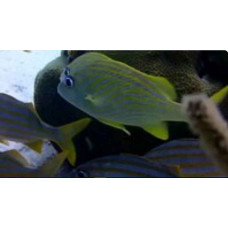Latin name
Haemulon flavolineatum
Other names
Spanish: ronco amarillo.
Identification
Its coloring is white to bluish or yellowish, with bright-yellow stripes. The stripes set below the lateral line are diagonal. There are yellow spots on the bottom of the head. The fins are yellow, and the inside of the mouth is blood red. It has 14 to 15 dorsal rays, 8 anal rays, and 16 to 17 pectoral rays.
Distribution
The French grunt is abundant in Florida, the Bahamas, and the Caribbean. It is also found in the waters of South Carolina, Bermuda, the Gulf of Mexico, and as far south as Brazil.
Habitat
Preferring shallower water close to shore, the French grunt inhabits coastlines and deeper coral reefs in depths from 12 to 60 feet. Grunt populations are less prominent around islands lacking large expanses of grassbeds and sand flats.
Size
The average length is 6 to 10 inches, can be as long as 12 inches.
Life history and Behavior
Fish drift in small or large groups that can number in the thousands. They move in the shade during the day. Juveniles hide in grass beds in bays, lagoons and coastal waters.
Food and feeding habits
They dig crustaceans on sandbanks and herbs near reefs.
Reproduction
No information
| Classification | |
| Phylum | Chordata |
| Class | Actinopterygii |
| Squad | Perciformes |
| Family | Haemulidae |
| Genus | Haemulon |
| Species | H. flavolineatum |
| Features | |
| Conservation status | Least Concern |
| Habitat | Pelagic |
| Life span, years | No information |
| Maximum body weight, kg | No information |
| Maximum length, cm | 30 |
| Sailing speed, m/s | No information |
| Threat to people | Edible |
| Way of eating | Bentophage |



